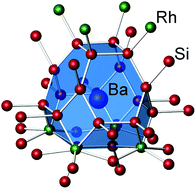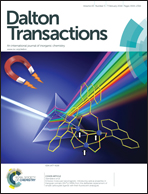BaRh2Si9 – a new clathrate with a rhodium–silicon framework
Abstract
The semiconducting compound BaRh2Si9 is a new kind of intermetallic clathrate. It was obtained by reacting BaSi, Rh and Si at 950 °C. The crystal structure (space group C2/c; Pearson symbol mC48, a = 6.2221(5) Å, b = 21.399(2) Å, c = 6.2272(5) Å, β = 90.306(7)°) displays a covalently bonded Rh–Si framework, in which four-connected Si atoms partly show unusually small bond angles. The Ba atoms are encapsulated in large polyhedral cages formed by 18 Si and 4 Rh atoms. The compound is a diamagnetic p-type semiconductor, which is in agreement with band structure calculations resulting in a band gap of 0.12 eV. Quantum chemical calculations reveal positively charged Ba atoms (Ba+1.3) and negatively charged Rh atoms (Rh−1). Si atoms with neighboring Rh atoms are positively charged, while those connected only with Si atoms are negatively charged.


 Please wait while we load your content...
Please wait while we load your content...